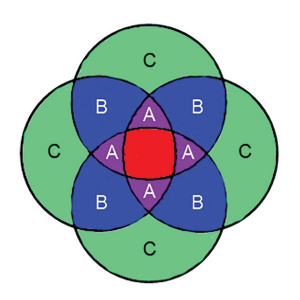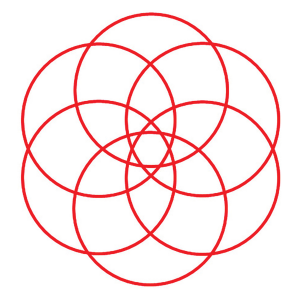WHAT IS THE SEARCH TARGET?
The search process is one of narrowing the universe of patents to subsets: the search topic, the search target, and the search goal. The topic is the technical area. The search target is the raw set of candidate patent records (created by database producers to collect related patent documents into patent families) that must be narrowed by the searcher to a reasonably small collection of patent documents. The search goal is the selected set of records that the patent attorney will rely on to render the FTO opinion.
 |
Figure 1: Four-component search matter |
 |
Figure 2A: Six-component search matter |
The search target may be straightforward, such as in the case of a simple new chemical or device or a new use for either of them. More often, the subject matter is complicated by many components, parts, steps, conditions, and the like. This would include chemical formulations or personal care products for which the list of ingredients may be very long. It could also include many mechanical and electronic devices that have long parts lists and operating manuals. Such matters call for extra care and skill in defining the search target. This is why I consider Rule 1, “Verify and verify again the scope with the customer,” to be critical. The searcher must understand the search goal before defining the search target and proceeding with search strategy development. Patent attorneys and technical experts are not searchers and frequently do not offer all the critical factors needed to design appropriate search targets. The skill of the patent searcher comes into play by asking the right questions before proceeding.
Consider a common way that people go about searching. The usual visual is the Venn diagram of overlapping circles. I have shown a four-component Venn diagram (see Figure 1 at right) that is more representative of relatively complicated formulations, processes, or devices than an often seen three-component Venn diagram that seems to be standard in such discussions.
One search approach is brute force: Search for every component, represented by the central red square. A case could be made for requiring all four components, such as for finding any obvious records, as emphasized by Rule 2: “Don’t miss the obvious references.” References with all the components might be appropriate for novelty or invalidity searches or helpful for making arguments for the concept of a “safe harbor.” I have seen some searches in which this look-for-everything approach is supported by using multiple databases and as many value-added resources as possible. This could be consistent with Rule 3: “Carry out the search in two independent parts.” However, searching broad and wide seems to be done on the mistaken understanding that searching extremely thoroughly for all the components is a substitute for searching for the right components. What it does is add to the cost and time spent, but it does not get at the important aspect of searching for the right target.
Searching for all of the components is not sufficient for FTO searching, because patents that claim fewer than all of the components may well have an impact on FTO. Furthermore, a search for all of the components may result in zero hits, which does not mean there are no patents of interest. Another common approach is to arbitrarily relax the number of required components in accordance with the size of the resulting candidate answer sets. Should candidate patents contain just three components (A), two components (B), or even just one (C)? How does one decide on the basis of the size of the candidate sets? In truth, it is not just a matter of the number of hits. Not all components are of equal importance. Each component must be fully understood in the context of the overall matter to be cleared for commercial operation.
The more complicated six-component Venn diagram shown in Figure 2A below may look daunting. Such matters may often be simplified by careful analysis of the components. Components may be categorized as active or inactive, or as critical, auxiliary, supplementary, helpful, or even as optional. Some may be relatively new and be covered by simple claims in recent patents, while others may be mature and likely to be claimed in enforceable patents only in combination with other components or conditions. Finally, some may be members of a class that should be searched as a class in addition to each named component.
For the sake of illustration, the six components might be resolved to the situation illustrated in Figure 2B below. In this case, the components are determined to be Critical (A), Important (either B or C), or common or mature (D, E, and F). In effect, the search boils down to A and (B or C). If component A is really critical, it could even be necessary to look at every patent containing that component. Searching for the mature components in combinations in case they were recent patented is also advisable. It is helpful to add the concept of a practice area (P) or art group to narrow the search appropriately for the FTO considerations.
With this analysis, I have basically returned to a three-component Venn diagram. It is interesting to note how the size of the two- and three-component areas appear so different,
in contrast to what is often depicted in a symmetrical three-component Venn diagram. On the one hand, these are just representations, and the areas do not necessarily reflect the number of patents within them. On the other hand, it is helpful to recognize that it only takes one patent to destroy the client’s FTO, and that this one reference might come from a very small overlap of concepts or a very large one. It is the searcher’s job to find such important references regardless of the size of the candidate set.